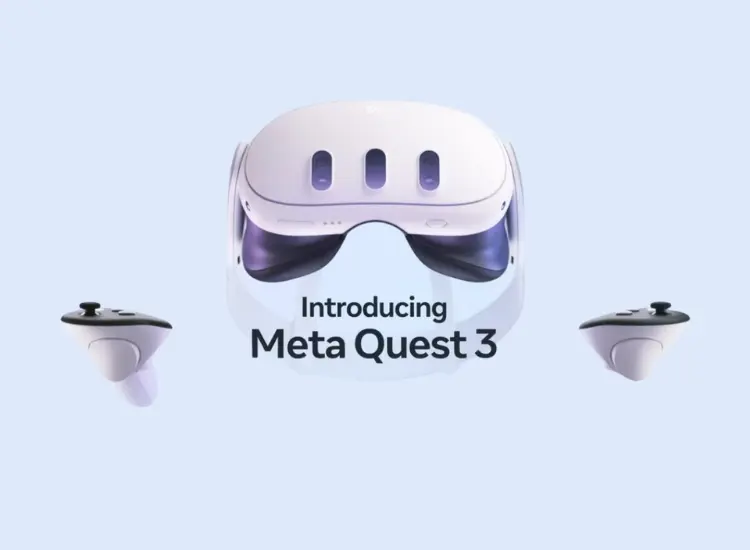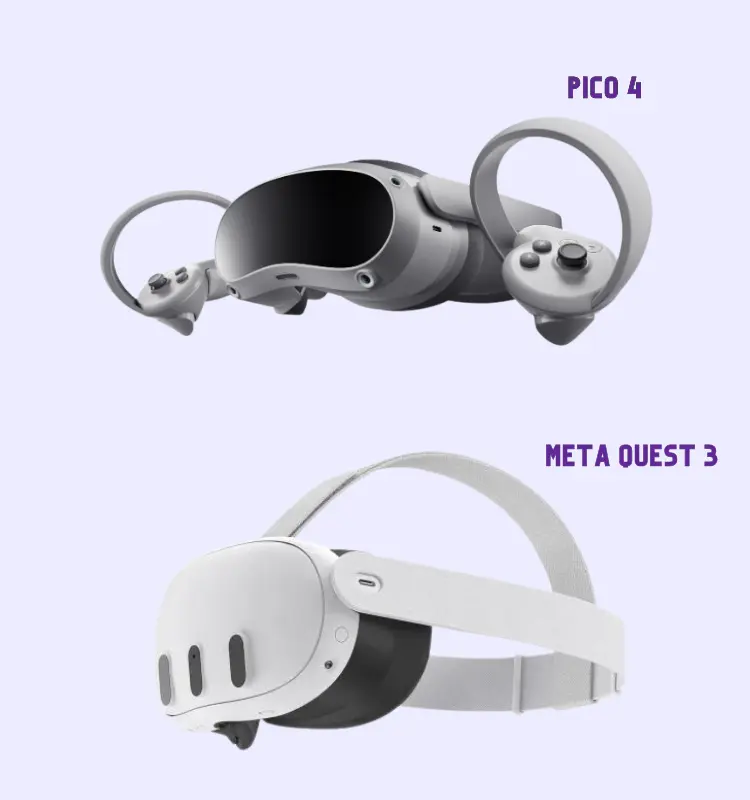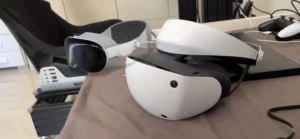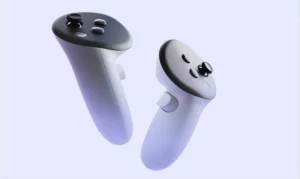
We are about to witness the competition heating up in the standalone VR headset arena with the forthcoming showdown between the Pico 4 vs Meta Quest 3, the latter set to release in the fall of 2023. This will surely create some revolutionary changes and development in the scheme of playback and gaming systems. People will witness something they have never witnessed before with the implementation of cutting-edge technology.
Here, we have precisely brought up a comparison between these two hot gears of the century.


Processing Power:
Most obviously, the Meta Quest 3 and the Pico 4 differ from one another in the amount of processing power each can give on its own. The development team behind Meta, the sequel to Quest 2, prioritized the speed and visual quality of VR games. Therefore, the Meta Quest 3 utilizes the Snapdragon XR2 Generation 2 CPU and the Adreno 740 GPU. Pico 4 uses a first-generation Snapdragon XR2 processor and an Adreno 650 GPU.
That means the Meta Quest 3 will provide speeds that are 2.5 times faster than the Pico 4, together with a graphical performance that is twice as powerful. Therefore, the Meta Quest 3 will provide far better performance than the Pico 4 for use with stand-alone virtual reality games. It’s a shame that the Meta Quest 3 doesn’t have eye tracking, since this would have allowed for more nuanced and responsive gameplay, faster load times, and longer battery life thanks to foveated rendering.
Let’s read! Apple Vision Pro vs Quest 3
Rendering powers
When compared to Meta Quest 3, Pico 4’s visuals are far more impressive. The Quest 3’s superior processing power makes it the best option for running VR games and programs, but the Pico 4’s superior display performance makes it the better overall choice.
The Pico 4 has two separate LCDs, one for each eye, and each is 2160 pixels on the diagonal. These panels provide a 97-degree (104-degree rendered) field of view when viewed via a pancake lens. This produces a pixel density of 20.8 PPD, which is very high for a standalone VR headset and guarantees a very clear and immersive experience.
The Meta Quest 3 uses a single LCD, splitting the display’s resolution of 2064 by 2208 between the left and right eyes while maintaining the same pancake lens and field of view. The resulting pixel density of 19.8 PPD is slightly lower than that of the original. The Pico 4’s dual LCD architecture better mimics human eyesight. As a result, users can experience virtual reality (VR) content with more ease and an enhanced sense of depth. The Pico 4 is distinct because of its two screens. The availability of a second display allows users to fine-tune the IPD for the greatest possible visual experience.
Despite this, there is not much of a distinction between the two VR systems in terms of display performance.
Meta Quest 3’s Mixed Reality Experience Beats Pico 4’s
It’s worth noting that the Meta Quest 3 uses two cameras to provide a stereoscopic passthrough, even though it only has a single display for both eyes. However, the Pico 4 only uses a single camera for video passthrough. Because of this, the Meta Quest 3 is superior to previous iterations of mixed reality headsets in terms of precisely simulating human eyesight and depth perception.
While the Pico 4 lacks this capability, the Meta Quest 3 comes with a specialist LiDAR depth sensor. This makes it so the Quest 3’s mixed reality windows and digital objects blend better into the user’s environment.
Dig your knowledge! Meta Quest Pro Vs Pico 4
Differences Between the Meta Quest 3 and Pico 4 Controllers
The unreleased Meta Quest 3 controller details are currently sketchy at best. However, the things that have been revealed and the hints that have been dropped all point to an exceptional virtual reality gaming experience.
The enhanced controllers, dubbed Touch Plus, have haptic feedback thanks to the inclusion of Meta’s Tru-Touch technology. Sensing technology like this incorporates touch sensors into the grip and trigger to provide discrete rumbles for a more immersive experience. If the Tru-Touch haptics is anything like the PSVR 2’s sensing controllers, then we are in for a genuine treat, even though we have not yet had the chance to put this to the test.
Contrarily, the Pico 4 controllers’ haptics aren’t as dynamic or complicated, and they only appear in specific places.
Finally, it is expected that the Meta Quest 3’s Touch Plus controllers will allow for more precise tracking than the Pico 4 controllers. The Quest 3 headset’s LiDAR spatial sensor guarantees better tracking of the Touch Plus controllers, not because it has an inside-out tracking mechanism.
When Compared to Meta’s Virtual Reality Game Collection, Pico Store Fails to Measure Up
The Oculus store for the Meta Quest 3 offers a wider selection of freestanding VR games than Pico’s developing VR games catalogue, which includes exclusives like Just Dance VR. This is due to the Oculus Quest 2’s dominance in the virtual reality headset market, which now boasts the highest unit sales total in the history of the industry.
However, you’ll need to connect your standalone VR headset to your computer to use VR mods with Steam.
Other Points to Consider:
Meta has two additional Quest gadgets planned for release in 2023 and 2024. These gadgets are known as Stinson and Cardiff undercover. At this moment, it is unclear which of these headsets will ultimately replace the Meta Quest 2. If the developer maintains their current release schedule, Meta Quest 3 could come out as soon as the year after next.
Mark Zuckerberg provided some clues on the next Quest’s development timeline in the spring. He underlined the importance of incorporating eye and facial recognition, even if that meant making the device less portable or heavier. He explained that Meta’s mission is to create VR-emulation hardware that comes as close to the genuine thing as possible.
To keep production costs as low as possible, virtual reality headsets inevitably have to make sacrifices in design and construction. The statement by Zuckerberg suggests that Meta may wish to eliminate pancake lenses in Meta Quest 3 to make a place for eye and face tracking.
Pico, on the other hand, took a different tack with its Pico 4 model, which features pancake lenses but no eye or facial tracking. The higher-priced Pico 4 Pro variant is the only one with this capability.
It would be unexpected if the Meta Quest 3, due out in a year or two, kept using Fresnel lenses and looked as bulky as the previous helmet.
Shortly, the Meta Quest Pro (information) won’t be the only Meta headset with a smaller form factor, and the Pico 4 gives me faith that pancake optics will gradually become the standard starting in 2023 and that production costs will fall.
Please be aware that any links in an article that take you to an internet store could be deemed “affiliate links.” MIXED may receive compensation from the retailer if you decide to purchase after clicking on this link. There won’t be any pricing changes.
Related Post: Meta Quest 2 vs HTC Vive
Final Words
The price difference between the Pico 4 and the Meta Quest 3 is only $70, so picking one will come down to deciding which features and capabilities are more important to you. This standalone VR headgear is likely to be preferable to the Meta Quest 3, which came out a year later. Compared to the Pico 4, it will provide a much more robust virtual reality gaming experience thanks to its access to the expansive Oculus store, which houses a wide variety of standalone virtual reality titles.
Read More: Meta Quest 3 Vs Vive XR Elite






